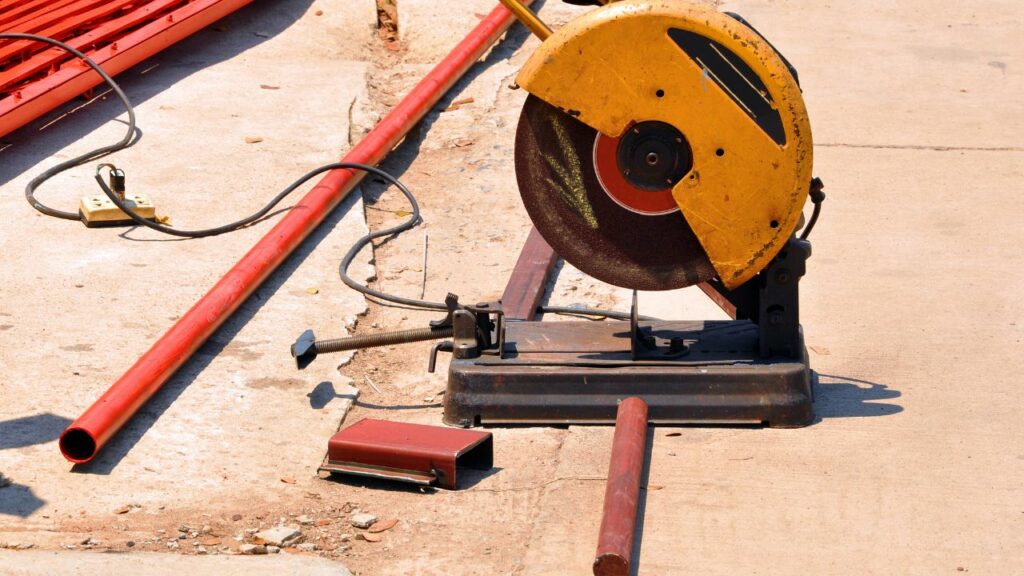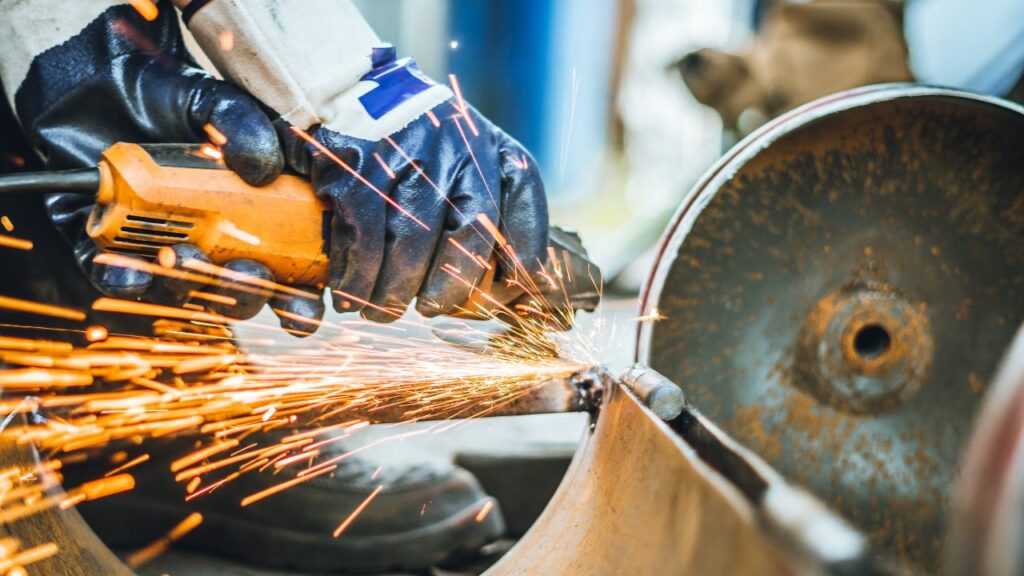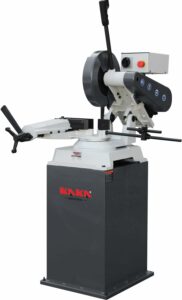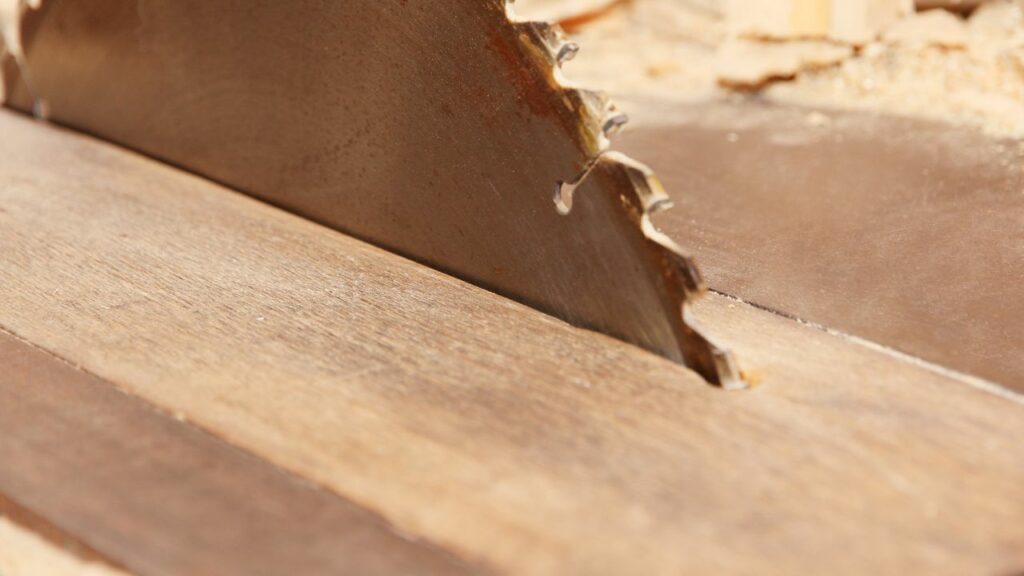Last Updated on October 18, 2023 by Pro Handyman Australia – Editorial Team
The simple answer to whether you can put a cold cut blade on an abrasive saw is: it’s not recommended. Same way, different types of saws have also different usage. Cold cut blades and abrasive saws are designed differently and serve distinct purposes. Just as one would research the best circular saw for a specific job, understanding blade compatibility is crucial. Using a cold cut blade on an abrasive saw might not yield the desired results and could even be hazardous.
Exploring the Essentials of Abrasive Chop Saws
Abrasive chop saws are primarily table-top tools specifically designed for cutting hard materials such as metal. Their distinguishing feature is the use of an abrasive disc, similar to those on grinding wheels but significantly thinner. These saws have a construction where the cutting wheel and the motor are attached to a pivoting arm, which is anchored to a stationary base. This base frequently incorporates a vise or clamp to hold materials securely in place. Typically, the cutting discs used are approximately 14 inches in diameter and 7/64 inches thick, though larger versions of these saws might use discs as big as 16 inches in diameter. One of the notable characteristics of abrasive saws is the utilization of discs embedded with materials like diamond or cubic boron nitride, ensuring longevity compared to standard blades.

Abrasive saws function differently; they utilize a disposable abrasive disc driven by a high-speed motor to grind their way through materials. Their speed and efficiency make them especially suited for softer materials, including aluminum, plastic, or wood. In terms of cost and size, abrasive saws have an edge; they are generally less pricey and more compact than cold cut saws. Nevertheless, there are downsides: they generate a significant amount of sparks, which can lead to thermal damage and discoloration of the workpiece, necessitating extra finishing work. The lifespan of abrasive saws is shorter, requiring more frequent blade replacements. Over time, this can escalate their cumulative costs.
The Cold Saw Alternative
While cold saws have a somewhat similar purpose to abrasive chop saws, they employ a different cutting technique, distinguishing their functionality from other tools like the scroll saw. Cold saws use a circular toothed saw blade and, often, a liquid coolant that transfers the generated heat to the chips produced during the cutting process, ensuring that both the blade and the material remain cool. In contrast, scroll saw uses involve precision work and intricate designs in woodworking, a stark difference from the robust functionality of cold saws. The design of cold saws comprises a blade and motor connected to an arm, which pivots, allowing the blade to move vertically downwards through the material. Larger versions operate on the same principle but might employ different, occasionally automated, methods to lower the blade, further highlighting the varied applications of cutting tools in the industry.
Challenges with Abrasive Saws
Abrasive saws come with their own set of challenges. Their operation tends to be noisy and can generate substantial amounts of dust and debris. This is due to the abrasive discs creating a high degree of friction upon contact with materials, leading to amplified sound and particulate production. Another concern is the swift wear and tear of abrasive discs, especially when employed on softer substances like wood or plastic.
Cold Cut Saws: An In-depth Insight and Benefits
If you’re wondering what is a cold cut saw, then here’s your answer. Cold cut saws employ a high-quality tungsten carbide blade capable of cutting through a myriad of materials without causing sparks. The hallmark of these saws is their ability to produce accurate, smooth cuts devoid of any distortion or discolouration, eliminating the need for any subsequent finishing work. When it comes to cutting harder metals, cold cut saws are superior in efficiency compared to abrasive saws. However, they might not be the best fit for slicing through thin materials, given their thicker blades, longer setup time, and higher maintenance demands.

A standout feature of cold cut saws is their versatility; they can effectively cut through metals, plastics, and composites without inflicting any damage. Generally, when compared to other power saws like abrasive saws, the operational costs of cold cut saws tend to be lower.
Cold Cut vs. Abrasive Saws: A Comprehensive Comparison
Comparing the Two: Benefits and Limitations
When it comes to the abrasive chop saw, its primary cutting mechanism involves grinding away the material. This process is quick but is also noisy and can be messy. Therefore, it’s advisable not to use this saw in proximity to combustible materials. Despite its speed, this tool does have drawbacks. It doesn’t always produce clean edges on the workpiece, and the blade can deviate from its intended path, compromising accuracy. Furthermore, since it grinds the metal, using it on softer materials like aluminum can clog the blade. However, due to its affordability and capability to cut robust metals swiftly, it remains a favorite in metal fabrication workshops.
On the other hand, cold saws, with their toothed blades, remove material in a chipping action as the blade rotates. These toothed blades tend to be more expensive than their abrasive counterparts, often costing upwards of $200 depending on the blade’s composition and dimensions. One of the standout features of cold saws is their ability to produce clean cuts with minimal rough edges. The liquid coolant not only keeps the material cool but also lubricates the blade’s teeth, resulting in faster cuts and a heat-free finished product. Furthermore, due to their slower blade rotation, cold saws can handle a range of materials from softer metals like aluminum to tougher ones like rebar.
Deciphering the Differences: Cold Cut Saws vs. Abrasive Saws
Factors to Consider in Your Decision
When torn between a cold-cut and abrasive saw, various factors come into play, including the consideration of alternative options. You might find yourself asking what is a band saw in the quest for a tool that bridges the gap between the extremities of cold-cut and abrasive saws. The kind of material you’re dealing with, particularly its size and hardness, can sway your decision. Cold cut saws, with their larger blades, offer efficiency but demand powerful motors. Conversely, abrasive saws are adept at handling softer materials and are compatible with smaller motors. Amidst these considerations, band saws emerge as versatile contenders, capable of meeting a broad spectrum of cutting requirements. If you’re weighing cost-effectiveness against efficiency, it’s also beneficial to explore band saws. While cold cut saws might be pricier initially, their long-term operating costs can be lower due to their less frequent maintenance needs compared to abrasive saws, and band saws often present a balance between the two, representing a comprehensive investment for diverse cutting tasks.
Safety First in Operations
Regardless of the type of saw you’re using, safety should never be compromised. For abrasive saws, maintaining clear visibility is paramount to steer clear of eye hazards. The dust generated by the abrasive blades can be harmful if inhaled, and the sparks might lead to thermal injuries. In contrast, cold cut saws have the advantage of producing minimal dust and no sparks, enhancing operational safety. However, irrespective of the tool, ensuring the use of appropriate eye and ear protection is crucial.
Abrasive Saws: Why They Shine
Abrasive saws excel in their ability to swiftly and efficiently cut through hard materials. The abrasive discs are adept at grinding down metal or stone, making these saws particularly suitable for tough cutting tasks. Another merit of abrasive saws is their higher cutting capacity, allowing them to accommodate larger material pieces than cold cut saws.
Drawbacks of Cold Cut Saws
Cold-cut saws, while precise, do exhibit some limitations. Their cutting speed is generally slower in comparison to other power saws, primarily because cold-cut blades necessitate cooling with water. This cooling process prevents damage to the material but can decelerate the cutting operation. Additionally, cold-cut saws are often restricted by a smaller cutting capacity when compared to their counterparts.
Making the Right Choice
Selecting the appropriate cutting tool is vital for achieving precise and swift cuts without deforming the material. In the debate of jigsaw vs circular saw, both cold-cut and abrasive saws also stand out as top choices, complicating the decision due to the involved technicalities. This guide aims to shed light not only on the unique features, benefits, and limitations of each option but also extends the discussion to include these alternative cutting solutions, helping users make an informed decision based on their specific needs.
Hands-On User Experience with Cold Cut Blades on Abrasive Saws
Over the past few months, many professionals and DIY enthusiasts have been experimenting with using cold cut blades on abrasive saws, leading to a slew of mixed reactions. Let’s dive into some of the firsthand experiences shared by users.


Jason, a metalworking professional for over a decade, tried the Makita Cold Metal Cutting TCT Saw Blade on his Milwaukee M18 FUEL 2990-20 abrasive saw. He noted, “The blade seemed a bit out of place initially, and I had my reservations. However, to my surprise, the cut was cleaner than I expected. Though, I did have to alter my speed a bit to get optimal results.”


On the other hand, Melissa, a DIY hobbyist, tried the Value Saw Blades 3502540BO180T blade on her KAKA Industrial TV-12 abrasive saw. She shared, “I found the experience a bit challenging. The blade didn’t fit as seamlessly as I had hoped, and I experienced a few sparks. Maybe it’s more suited for professionals, but for my small projects, I might stick to the standard abrasive disc.”
While experiences vary, the consensus seems to be that while it is possible to fit a cold cut blade on an abrasive saw, the outcome can be hit or miss. Adjustments, both in terms of speed and fitting, are often necessary.
In-Depth Comparisons: Cold Cut Blades on Different Abrasive Saws
To better understand the compatibility and performance of cold cut blades on abrasive saws, let’s compare how some of the top models fare.
| Abrasive Saw Model | Compatible Cold Cut Blade | Power (Watts) | Longevity (Hours) | Price (USD) |
|---|---|---|---|---|
| Milwaukee M18 FUEL 2990-20 | Makita Cold Metal Cutting TCT Saw Blade | 1400 | 85 | $220 |
| KAKA Industrial TV-12 | Value Saw Blades 3502540BO180T | 1300 | 75 | $190 |
| SKILSAW SPT84-01 | Austsaw High Speed Steel Cold Cut Blade | 1200 | 80 | $200 |
From the table, we can deduce that the DeWalt D28715, when paired with the Makita Cold Metal Cutting TCT Saw Blade, offers the best power, while the KAKA Industrial TV-12 provides a more budget-friendly option. However, the SKILSAW SPT84-01 stands out in terms of a balance between power, longevity, and price.
Cold Cut Blades on an Abrasive Chop Saw: A Mismatch

When exploring the various types of power saws, it’s essential to know their specific functionalities and compatibilities. Just as understanding jigsaw blade types is crucial for optimal woodworking, it’s equally important to recognize blade compatibilities for other tools. Using a cold cut saw blade on an abrasive chop saw is not recommended. This is mainly because abrasive chop saws operate at much higher speeds than what a cold cut blade is designed to handle, with the latter working effectively at just a few hundred RPMs.
Conclusion
Navigating the realms of cold-cut and abrasive saws reveals that both are formidable cutting tools, each excelling in its own domain. In places like Melbourne Handyman Services often weigh the decision to opt for one over the other based on specific cutting needs, material requirements, and budgetary constraints. Cold-cut saws stand out when precision, undistorted finishes, and thicker material handling are paramount. On the other hand, if speed, efficiency, and affordability are top priorities, especially for thinner materials such as plastic or aluminum, abrasive saws are the go-to option. However, their usage might result in thermal damage, necessitating post-cut refinements. Whichever path you choose, it’s crucial to keep safety at the forefront and adhere to the manufacturer’s guidelines to achieve optimal outcomes.
